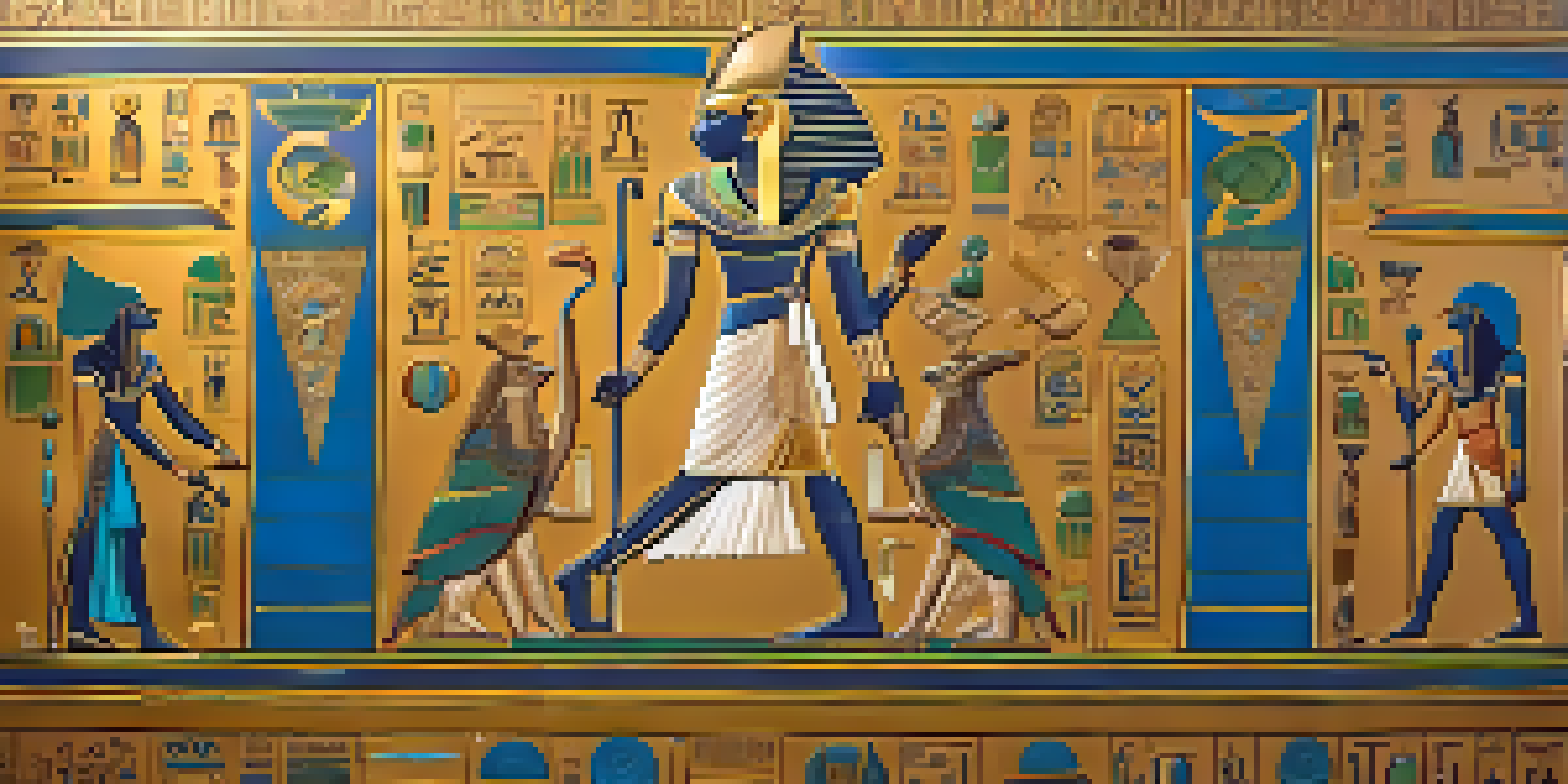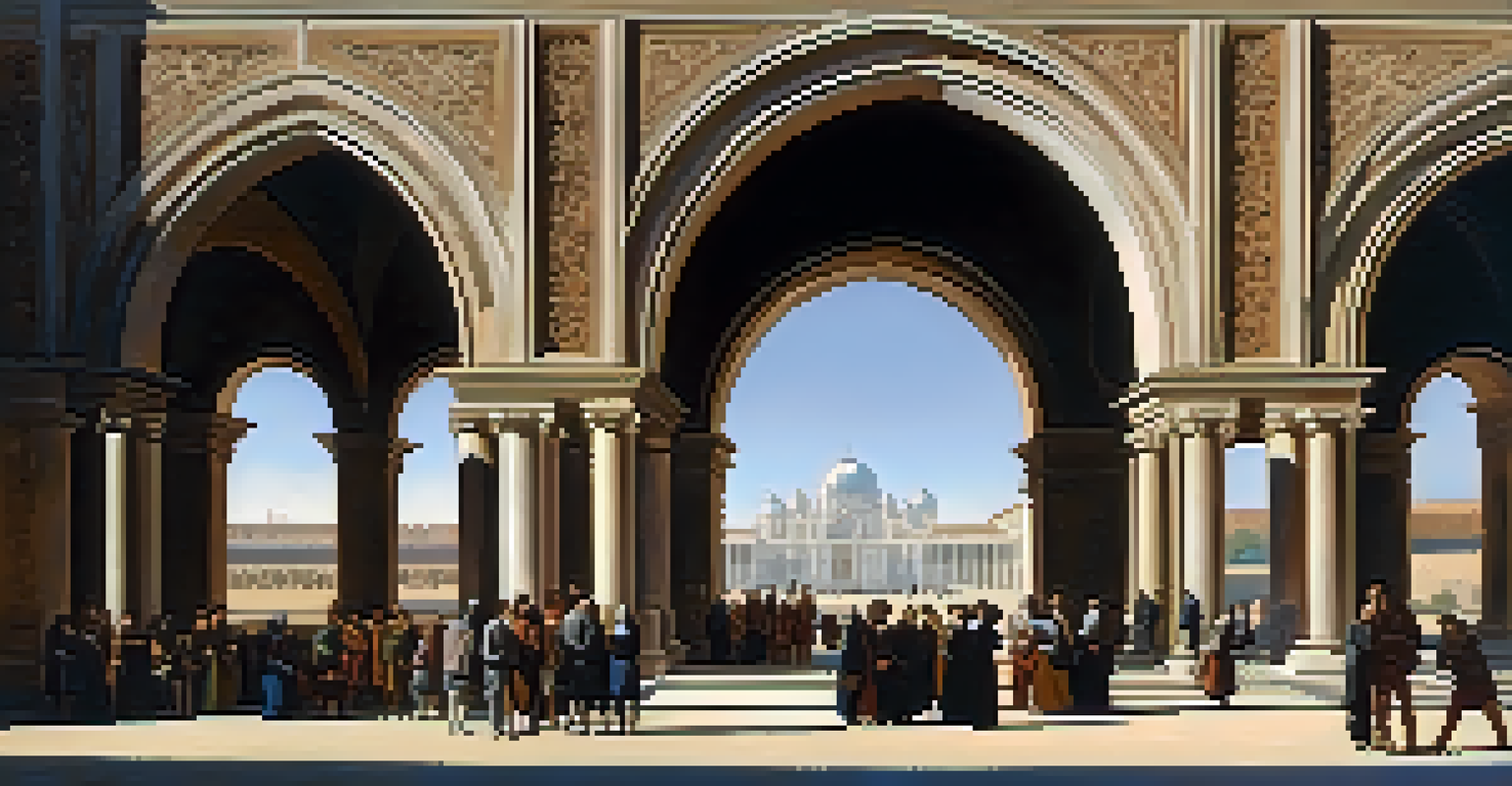Historical Perspectives on Color Use in Fine Art Movements

The Role of Color in Ancient Art Traditions
In ancient art, color was not just aesthetic; it held profound symbolic meaning. For instance, in Egyptian art, colors like gold represented the divine, while blue symbolized the Nile and fertility. Artists mixed natural pigments from minerals and plants, creating a palette that conveyed social and spiritual narratives.
Color is the keyboard, the eyes are the harmonies, the soul is the piano with many strings.
This connection between color and meaning can be seen in the frescoes of Pompeii, where vibrant hues told stories of mythology and daily life. The use of color was meticulous, with artists understanding how different shades could evoke emotions or signify status. Thus, color became a language of its own, communicating with viewers across time.
As we delve deeper into these ancient practices, we see a foundation laid for the complex use of color in later art movements. The reverence for color as a tool for storytelling continues to resonate, influencing how artists approach their palettes today.
Renaissance: The Birth of Color Theory
The Renaissance marked a pivotal shift in the understanding of color, moving from symbolic to scientific approaches. Artists like Leonardo da Vinci began studying light and shadow, establishing the groundwork for color theory. This period saw the emergence of techniques like chiaroscuro, which used contrasting colors to create depth and realism.

Color during the Renaissance was no longer merely decorative; it became a vehicle for emotional expression and realism. For instance, Raphael's use of soft pastels in 'The School of Athens' draws viewers into a harmonious space, showcasing the beauty of intellectual pursuit. This intentionality in color selection illustrated a deeper relationship between the artwork and its audience.
Color as Symbolism in Ancient Art
In ancient art, colors conveyed deep symbolic meanings, reflecting social and spiritual narratives.
Moreover, the introduction of oil paints allowed for richer colors and more nuanced blending. Artists could now layer pigments to achieve a luminosity that was previously unattainable, paving the way for future movements to explore color in even more innovative ways.
Impressionism: Capturing Light and Emotion
The Impressionist movement revolutionized the use of color by emphasizing the effects of light on the landscape. Artists like Claude Monet famously painted en plein air, or outdoors, capturing the fleeting moments of sunlight dancing on water. This approach led to the use of vibrant, unmixed colors applied in short, visible brushstrokes, which created a sense of movement and spontaneity.
Colors, like features, follow the changes of the emotions.
Color in Impressionism became a means of personal expression, conveying the artist's emotional response to a scene rather than a literal representation. For example, Monet's 'Impression, Sunrise' uses warm oranges and cool blues to evoke the tranquility of dawn, inviting viewers to feel the atmosphere rather than just observe it.
This shift from realism to a focus on perception opened the door for more abstract uses of color in later movements. The Impressionists laid the groundwork for artists to explore color’s emotive power, leading to even bolder applications in the 20th century.
Fauvism: The Wild Beasts of Color
Fauvism, characterized by its bold, saturated colors, emerged in the early 20th century as a reaction against the subdued tones of Impressionism. Artists like Henri Matisse and André Derain used color as an independent element, often applying it straight from the tube to create shocking contrasts. This movement's name, derived from the French word for 'wild beasts,' reflects its unapologetic approach to color.
The Fauvists believed that color should express emotional significance, rather than merely represent the natural world. In works like Matisse's 'Woman with a Hat,' the unconventional color choices create a vibrant, almost dreamlike quality that challenges viewers' perceptions. This experimentation with color pushed the boundaries of how color could be interpreted and appreciated.
Evolution of Color Theory
The Renaissance marked a shift from the symbolic use of color to a scientific understanding, influencing emotional expression in art.
Fauvism's emphasis on color as a primary means of expression inspired subsequent movements, encouraging artists to explore even more radical uses of color, paving the way for future avant-garde styles.
Expressionism: Emotion Through Color
Expressionism took color to new emotional heights, focusing on conveying feelings rather than depicting reality. Artists like Edvard Munch used vivid, distorted colors to express angst and turmoil, as seen in his iconic work 'The Scream.' Here, color becomes a direct reflection of inner emotion, transforming the canvas into a visceral experience for the viewer.
The use of color in Expressionism often involved dramatic contrasts and non-representational palettes to evoke strong feelings. This approach challenged traditional notions of beauty, instead prioritizing the emotional impact of color. For instance, the use of dark reds and blues in Munch’s work creates an unsettling atmosphere that resonates deeply with the viewer’s psyche.
As a result, Expressionism set the stage for future explorations of color in abstract art, reinforcing the idea that color could transcend mere representation and become a powerful tool for emotional communication.
Abstract Art: Freedom of Color Expression
With the rise of Abstract Art in the mid-20th century, color became an even more liberated form of expression. Artists like Mark Rothko and Wassily Kandinsky experimented with pure color and form, focusing on the emotional resonance of their compositions rather than representational content. This shift allowed color to exist independently, inviting viewers to engage with the artwork on a purely emotional level.
Rothko’s large fields of color create an immersive experience, where viewers can feel the intensity of the hues. His works often evoke meditative responses, highlighting the spiritual and psychological implications of color. Similarly, Kandinsky believed that color had the power to evoke specific emotions and ideas, leading him to create dynamic compositions filled with vibrant colors.
Color's Emotional Impact in Art
Movements like Expressionism and Abstract Art showcased color's capability to evoke emotions and challenge traditional representation.
The freedom of color in abstract art challenged the boundaries established by previous movements, encouraging artists to explore personal interpretations and emotional connections. This opened doors for future generations to continue experimenting with color in innovative ways.
Conclusion: The Timeless Impact of Color in Art
Throughout history, color has evolved from a mere tool of decoration to a profound means of expression in fine art. Each movement, from the ancient traditions to modern abstract works, has contributed to our understanding of color’s emotional and symbolic significance. This journey illustrates how artists have harnessed color to communicate complex ideas and feelings across centuries.
The legacy of color in art continues to inspire both artists and audiences today. As contemporary artists experiment with new mediums and techniques, the exploration of color remains a central theme, reflecting our ongoing fascination with its power. Whether through vibrant palettes or subtle tones, color continues to shape the art world.

Ultimately, the historical perspectives on color use in fine art movements remind us that color is not just a visual element; it is a language that transcends time, inviting us to connect with the emotional depth of art.